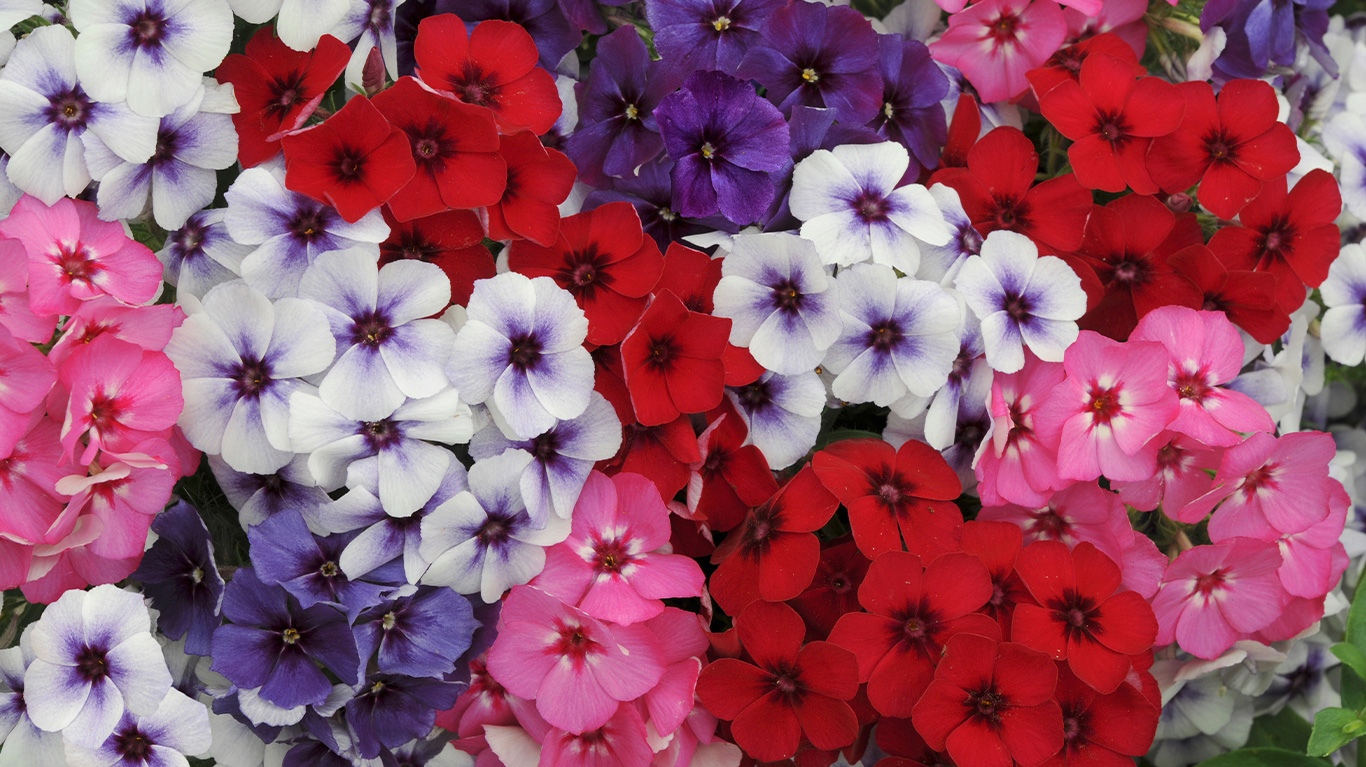How to Plant & Grow
Phlox
Phlox are gorgeous herbaceous plants that are perfect for a wildflower or cottage garden display. These plants are hardy and easy to grow, perfect for a low-maintenance display as well.
If it’s your first time growing phlox, then you’re likely after an easy guide that shows you how to grow your new plants. Thankfully, that’s exactly what this is! Follow our how-to-grow phlox guide for a successful planting experience.

What We've Included
When to Plant | How to Plant | Where to Plant | When to Water | Should I feed my Phlox? | How to Mulch | Deadheading | How to Propagate | Common Issues | Phlox FAQs | Inspiration
When to Plant Phlox
Phlox grown in pots can be planted outside in spring or autumn. Loose roots can be planted out if the ground isn’t frozen or potted up as soon as they have arrived in winter.
How to Plant Phlox
Planting Pot-Grown Plants
Our pot-grown plants are incredibly easy to plant and grow. Whether you’re growing them directly outside into the border or into a container, our pot-grown plants are a breeze from the moment they arrive.
- Dig a hole in the border that’s big enough to house the root system. If planting in pots, fill a large pot halfway with potting soil and then make a well in the middle. Do this until the top of the soil from the plant is just below the top of the pot.
- Wedge in the plant by adding soil to the gaps in the hole, firming down the surface to ensure it’s in place.
- Water well and you’re done!
Planting Loose Roots
Loose roots to beginners might sound intimidating but are really easy to plant! They’re also a budget-friendly way of growing your favourite plants.
Here’s how to plant loose roots:
- Soak roots in a bucket of water for 1-2 hours before planting.
- Dig a hole in the border that’s big enough to house the root system. If planting in pots, fill it halfway with potting soil and then pop the roots in with the crown pointing upwards and the root system pointing to the floor.
- Plant in groups for a fuller display, usually in groups of 3, somewhere that gets plenty of sunlight.
- Ensure the crown is just below the soil unless the plant has some leaves, in which case leave them exposed with the rest of the root system under the soil.
- Water well once planted.
Where to Plant Phlox
These plants can handle a full sun or partially shaded spot in the garden. Depending on the height of the variety you’ve chosen, they can be grown in the back of a border (if it’s tall) or in a container (if it’s compact). Some varieties are perfect for sunny rock gardens, and the half-hardy annual group are great for bedding.

When to Water Phlox
Water Phlox plants regularly for its first two years. Once it has established, it will cope without extra watering (except in periods of drought or particularly warm and dry spells). Any varieties grown in a container will need regular watering throughout summer, regardless of their age, as they will drain quickly.
Should I Feed My Phlox?
You don’t really need to feed your Phlox, as it will pull nutrients from the soil. However, if you’re working with poor soil conditions, then you can apply a general fertiliser in spring.
How to Mulch Phlox
We always recommend adding a healthy layer of mulch around the base of a shrub. This can be a mixture of well-rotted compost or manure. This will help the soil retain moisture throughout spring and into summer.

Should You Deadhead Your Phlox?
Deadheading spent flowers can cause more flowers to appear in autumn. Cut off a flower head just above a node of leaves.
How to Propagate Phlox
When left to grow, phlox can become quite dense and overcrowded. You may notice a lack of flowers or a sparse middle. This means that your phlox is ready to be divided, which you can do every spring before it starts to bloom again.
To divide any plant, dig it up gently and split it in half or into sections with a sharp knife or spade. Replant these new clumps about 60cm apart, ready for them to flower that same season!
You can also propagate Phlox by taking root cuttings in winter. Dig the plant up gently and take a few root cuttings. Pop the cutting into compost and place a clear bag around the pot, holding it in place with a rubber band or twine. Position out of direct sunlight, and somewhere warm.
Common Issues
Phlox shrubs aren’t particularly susceptible to pests and diseases. However, they can be bothered by powdery mildew in summer, if the plants aren’t kept watered.
Phlox FAQs
Q: Is phlox a perennial?
A: Phlox plants are perennial, meaning they die back at the end of their season and reappear the following year.
Q: When do phlox flower?
A: Most phlox varieties flower in summer, adding colour to your seasonal garden. However, we always suggest to double check a plant’s growing instructions to find out exactly when they'll bloom.
Q: Is phlox poisonous to dogs?
A: Phlox is a non-toxic plant, meaning it’s safe to grow in gardens occupied by animals or children.
Q: How tall do phlox grow?
A: Phlox are compact plants. Some are creeping plants, meaning they suppress weeds.
Q: Do slugs eat phlox?
A: Slugs hate the scent of Phlox paniculate. They simply cannot stomach it.
Ready to Shop?
Find some inspiration for your garden
